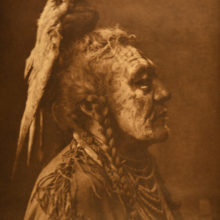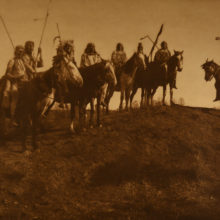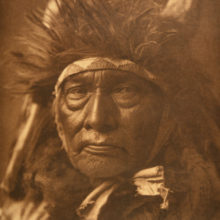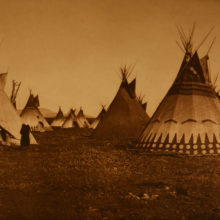March 12, 2021 - July 4, 2021
The Brinton Museum presents the exhibit “Bravery, Beauty & Sacred Power: The Cheyenne, Crow, Lakota & Blackfeet Portraits of Edward S. Curtis” comprised of photogravures from The North American Indian folios on loan from the Foundation for the Preservation of American Indian Art and Culture. This outstanding show opens in The Brinton Museum’s Jacomien Mars Reception Gallery in March 2021.
The Jacomien Mars Reception Gallery will be closed on Saturday, June 12 from 9:00 AM to 3:30 PM for the Edward Curtis Symposium, Bravery, Beauty and Sacred Power: The Photogravures of Edward S. Curtis.
A selection of photogravures from the spring exhibit will be on display in the S. K. Johnston, Jr. Family Gallery beginning in September.
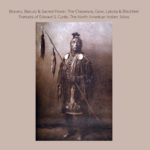 The “Bravery, Beauty & Sacred Power: The Cheyenne, Crow, Lakota & Blackfeet Portraits of Edward S. Curtis” exhibit catalog is available at The Brinton Museum Store. You may pick up a copy of the catalog in the store or order one online today.
The “Bravery, Beauty & Sacred Power: The Cheyenne, Crow, Lakota & Blackfeet Portraits of Edward S. Curtis” exhibit catalog is available at The Brinton Museum Store. You may pick up a copy of the catalog in the store or order one online today.
World-renowned for his superb photographs of North American Indians, the photographer Edward S. Curtis (1868-1952) spent more than 30 years documenting a people’s way of life that was quickly disappearing. His three-decades-long work culminated in the publication of 300 sets of folios during his lifetime, each comprised of photogravure prints depicting the beauty and dignity of the Indian peoples he came to know and respect.
“Over here!” After some back and forth, silhouettes appeared in the soup, accompanied by much chattering and staccato grumbling. They were a half-dozen men, adrift and confounded on one of Rainier’s most treacherous glaciers, the Nisqually, an ice field nearly five miles long.” ¹
In the summer of 1898, Edward Curtis was ten thousand feet high on Mount Rainier’s Nisqually, climbing the formidable, fog-covered glacier alone, when he heard the men’s cries for help. Among those he rescued that midsummer day was the preservationist and anthropologist George Bird Grinnell, widely renowned for his knowledge of Plains Indians; Clint Hart Merriam, co-founder of the National Geographic Society and chief of the U. S. Biological Survey; and Gifford Pinchot, head of the U. S. Forest Service.
Two years later, in 1900, Grinnell invited Curtis to join him on an expedition to witness a Sun Dance ceremony of the Blackfeet in Montana. By 1904, the Sun Dance ceremonies were banned by the U.S. Government. A people’s way of life, living free on sacred lands, was vanishing. It was then that Curtis made the monumental decision to photograph the remaining Indian tribes in North America. He had found a certainty of purpose. Sacredness and spirit of a people who had lived on these lands for centuries resonated in the passion of the man who was driven by fierce determination to photograph them all, to document the life and faces of a people for time immortal. Curtis’ photographs are oftentimes described as hauntingly beautiful.
He had the good fortune to secure the friendship of President Theodore Roosevelt through Grinnell, and Merriam. Comprehending the major importance of Edward Curtis’ work, Roosevelt introduced him to the American financier and banker J. Pierpont Morgan. Morgan, and his son, J. P. Morgan, Jr., provided a substantial amount of the funds needed for the publication of the North American Indian project. Set on a course to accomplish what no one else had attempted to do, Curtis documented in tens of thousands of photographs, and thousands of recordings, the faces, and voice of the North American Indian peoples. His extensive photographic venture to document all the Native American tribes west of the Mississippi required an extraordinary amount of financial resources. Funds to keep going eventually well exceeded the Morgans’ benevolent generosity. In the end, Curtis compromised his health, family relationships, and personal resources to continue working on what he saw as an “addition to the documentary knowledge of the human race.” ² He ultimately succeeded in achieving what no one else had been able to accomplish. His ethnographic record of the North American Indian remains today as his enduring legacy.
Edward Curtis published twenty-volume sets in The North American Indian folio series between 1907 and 1930. Three hundred sets were completed during his life. The Brinton Museum’s show includes 75 photogravures encompassing portraits of Crow Chiefs, Northern Cheyennes, Lakotas, Blackfeet, Oglala Sioux, and Assiniboine people.
¹ “Short Nights of the Shadow Catcher, The Epic Life and Immortal Photographs of Edward Curtis”, Timothy Egan, Mariner Books, Houghton Mifflin Harcourt, Boston, New York, 2013, pg. 25 ² Reference: Christie’s, Sale 2622, Important Books, Atlases and Manuscripts: The Private Library of Kenneth Nebenzahl”, New York, April 20


